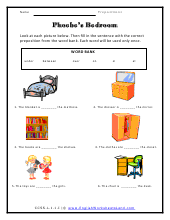Analogy Worksheets
An analogy is when we compare two things (ideas or things) that are seemingly different in many ways, but have some underlying common characteristic. Many times it displays a high level of skill in writing when they perfect analogy is set forth. Writers can often use analogies to explain complicated processes by relating them to simplistic processes or models. We have a wide range of analogy worksheets available. Click on the links below to be transported to these various analogy related worksheet categories. This skill is basically the active form of personal vocabulary. Analogies are used in everything from IQ tests to job entrance exams to gauge language ability. This wide array of worksheets will help your students explore and eventually master the use of analogies in their own written on spoken language. This takes a great deal of practice to perfect.
Connecting Individuals, Ideas, or Events - Students will start to flex their brain muscles to look for the interrelations between multiple variables.
Conveying Ideas with Words and Phrases - We start to learn about the use of effective language and how it can be very powerful.
Defining Categories for Words - This helps students begin to see how things are similar and yet different.
Explaining Similes and Metaphors - These are often confused with analogies, but the fact is they are much more subtle.
Inferring the Meaning Of Words and Phrases - This skill takes a great deal of practice and it is vital towards improving your ability to understand new vocabulary.
Literal versus Nonliteral Language - We explore this along with our analogies because when you examine this it can really help bolster your language.
Metaphors - These are much more poetic and melodic than your standard analogy.
Similes and Metaphors (Advanced) - This topic has slightly more complicate comparisons.
Sort Objects into Basic Categories - This is where we can start to identify similarities that we can make comparison with.
Sort Words into Categories - This simple skill has a huge impact on our ability to make a thoughtful analogy.
Understanding Relationships Between Words - Where is there crossover between your word and the one you trying to connect it with?
Word Relationships - This is a super handy collection of worksheets for this topic.
Analogy Worksheets To Print:
Doe It Make Sense? - Take in all of these different comparisons and see which one fits best.
Types of Them - How are the words related to each other? Choose one of the relationships provided and write it on the line.
How They Relate - Determine the relationship between the first set of words. Then fill in the blank with a word that creates the same relationship between the second pair of words.
Describing Relationships - Choose a word on the right that best expresses a relationship to the word on the left that is similar to that of the original pair.
Understanding What They Mean - To understand the analogy, first you need to figure out the relationship between the first pair of words. You can do this by making a sentence that relates the two words to one another. Write a sentence that explains the relationship between each pair of words.
Cap Them Off - Which choice best completes each thought?
Write Your Own - Find the relationship between the first set of words. Then fill in the blank with a set of words that have the same relationship.
Rewrite Them - Rewrite each analogy below so that it makes sense.
Whole to Part - For example: bee: hive :: ant : colony. The relationship expressed in a sentence looks like this: A bee is to a hive as an ant is to a colony. This analogy describes the relationship of a part to a whole.
How They Go Together - Identify the relationship that describes each situation.
Circle the Word - Complete each analogy by circling the correct word. Then explain why you chose each word.
Different Types - See if you can breakdown how those two things relate.
SAT Prep - These are commonly found on the language portion of the SAT exam.
Logical Thoughts - Rewrite each example by changing the last word so that it is correct and makes sense.
Last Practice Worksheet - We offer you another series of practice problems to get going with.
Get FREE English Worksheets In Your Email
